Seismic Performance and Buckling Length Calculation Method of Concrete-Filled Steel Tube Columns
Abstract
1. Introduction
2. Model Validation and Expansion
2.1. Model Establishment and Validation
2.2. Parameter Analysis
3. Result Analysis
3.1. Failure Mode
3.2. Load–Displacement Curve
3.3. Ductility Performance
3.4. Energy Consumption Capacity
4. Local Buckling Length
5. Conclusions
Author Contributions
Funding
Data Availability Statement
Conflicts of Interest
References
- Yang, J.; Feng, P. Analysis-oriented model for FRP confined high-strength concrete: 3D interpretation of path dependency. Compos. Struct. 2021, 278, 114695. [Google Scholar] [CrossRef]
- Zhou, Y.; Han, Q.; Du, X.; Jia, Z.-L. Shaking table tests of post-tensioned rocking bridge with double-column bents. J. Bridge Eng. 2019, 24, 04019080. [Google Scholar] [CrossRef]
- He, H.; Zhou, Y.; Cheng, S.; An, N.; Liu, H.; Fe, Z. Stability Analysis of “321” prefabricated highway steel truss bridge. Buildings 2024, 14, 1626. [Google Scholar] [CrossRef]
- Zhou, Y.; Han, Q.; Du, X.; Zhang, J.-Q.; Cheng, S.-S.; Chen, J.-Y. Additional viscous dampers for double-column rocking bridge system: Seismic response and overturning analysis. Soil Dyn. Earthq. Eng. 2021, 141, 106504. [Google Scholar] [CrossRef]
- Han, L.; Li, W.; Bjorhovede, R. Developments and advanced applications of concrete-filled steel tubular (CFST) structures: Members. J. Constr. Steel Res. 2014, 100, 211–228. [Google Scholar] [CrossRef]
- Shanmugam, N.E.; Lakshmi, B. State of the art report on steel–concrete composite columns. J. Constr. Steel Res. 2001, 57, 1041–1080. [Google Scholar] [CrossRef]
- Han, D.; Tao, Z.; Ghafar, W.; Hasan, M.; Xiao, W.; Wang, T.; Zhou, K.; Dai, H. Experimental study on the seismic performance of L-shaped CFST columns in different combinations. Buildings 2023, 13, 2320. [Google Scholar] [CrossRef]
- Wang, J.; Sun, Q.; Li, J. Experimental study on seismic behavior of high strength circular concrete-filled thin-walled steel tubular columns. Eng. Struct. 2019, 182, 403–415. [Google Scholar] [CrossRef]
- Gardner, N.J.; Jacobson, E. Structural Behavior of Concrete Filled Steel Tubes. ACI J. 1967, 64, 404–413. [Google Scholar]
- Chang, Y.; Chen, W.; Xiao, Q.; Rong, E.; Peng, L. Theoretical and experimental study on axial compression concrete-filled tubes with different confinements. J. Constr. Steel Res. 2021, 185, 106862. [Google Scholar] [CrossRef]
- Han, L.; Yao, G.; Tao, Z. Performance of concrete-filled thin-walled steel tubes under pure torsion. Thin-Walled Struct. 2007, 45, 24–36. [Google Scholar] [CrossRef]
- Tao, Z.; Wang, Z.; Yu, Q. Finite element modelling of concrete-filled steel stub columns under axial compression. J. Constr. Steel Res. 2013, 89, 121–131. [Google Scholar] [CrossRef]
- Ibañez, C.; Hernández-Figueirido, D.; Piquer, A. Effect of steel tube thickness on the behaviour of CFST columns: Experimental tests and design assessment. Eng. Struct. 2021, 230, 111687. [Google Scholar] [CrossRef]
- Wang, X.; Fan, F.; Lai, J. Strength behavior of circular concrete-filled steel tube stub columns under axial compression: A review. Constr. Build. Mater. 2022, 322, 126144. [Google Scholar] [CrossRef]
- Subedi, N.; Obara, T.; Kono, S. Noncompact and slender concrete-filled steel tubes under axial compression: Finite-element modeling and evaluation of stress-strain models for fiber-based analysis. J. Constr. Steel Res. 2022, 196, 107353. [Google Scholar] [CrossRef]
- Lai, Z.; Jiang, H.; Cai, Y. A new design equation to estimate the axial compressive strength of circular concrete-filled steel tubular stub columns. Structures 2022, 46, 1043–1054. [Google Scholar] [CrossRef]
- Han, L. Tests on Concrete Filled Steel Tubular Columns with High Slenderness Ratio. Adv. Struct. Eng. 2000, 3, 337–344. [Google Scholar] [CrossRef]
- Lakshmi, B.; Shanmugam, N.E. Nonlinear Analysis of In-Filled Steel Concrete Composite Columns. J. Struct. Eng. 2002, 128, 922–933. [Google Scholar] [CrossRef]
- Tu, C.; Shi, Y.; Liu, D.; Wang, W.; Ban, H. Behavior and general design method of concrete-filled high-strength steel tube (CFHST) columns. Eng. Struct. 2021, 243, 112506. [Google Scholar] [CrossRef]
- Nakahara, H.; Sakino, K.; Kawano, A. Bond Behavior of concrete filled steel tubular frames under cyclic horizontal load. J. Struct. Constr. Eng. 2008, 73, 465–472. [Google Scholar] [CrossRef]
- Zubydan, A.H.; ElSabbagh, A.I. Monotonic and cyclic behavior of concrete-filled steel-tube beam-columns considering local buckling effect. Thin-Walled Struct. 2011, 49, 465–481. [Google Scholar] [CrossRef]
- Wu, B.; Zhao, X.Y.; Zhang, J.S. Cyclic behavior of thin-walled square steel tubular columns filled with demolished concrete lumps and fresh concrete. J. Constr. Steel Res. 2012, 77, 69–81. [Google Scholar] [CrossRef]
- Petrus, C.; Hamid, H.A.; Ibrahim, A.; Parke, G. Experimental behaviour of concrete filled thin-walled steel tubes with tab stiffeners. J. Constr. Steel Res. 2010, 66, 915–922. [Google Scholar] [CrossRef]
- Lee, S.-H.; Choi, Y.-H.; Kim, Y.-H.; Choi, S.-M. Structural performance of welded built-up square CFST stub columns. Thin-Walled Struct. 2012, 52, 12–20. [Google Scholar] [CrossRef]
- Wang, Z.B.; Tao, Z.; Yu, Q. Axial compressive behaviour of concrete-filled double-tube stub columns with stiffeners. Thin-Walled Struct. 2017, 120, 91–104. [Google Scholar] [CrossRef]
- Wang, Y.; Yang, Y.; Zhang, S. Static behaviors of reinforcement-stiffened square concrete-filled steel tubular columns. Thin-Walled Struct. 2012, 58, 18–31. [Google Scholar] [CrossRef]
- Yang, Y.; Wang, Y.; Fu, F. Effect of reinforcement stiffeners on square concrete-filled steel tubular columns subjected to axial compressive load. Thin-Walled Struct. 2014, 82, 132–144. [Google Scholar] [CrossRef]
- Pang, B. Experimental Study on Seismic Performance of Circular Concrete-filled Steel Bridge Columns. Master’s Thesis, Chongqing Jiaotong University, Chongqing, China, 2012. (In Chinese). [Google Scholar]
- ABAQUS Inc. ABAQUS Analysis User’s Manual; Dassault Systèmes: Providence, RI, USA, 2013. [Google Scholar]
- Sayadi, A.A.; Rahman, A.B.; Jumaat, M.Z.B.; Alengaram, U.J. The relationship between interlocking mechanism and bond strength in elastic and inelastic segment of splice sleeve. Constr. Build. Mater. 2014, 55, 227–237. [Google Scholar] [CrossRef]
- Xu, C.S.; Liu, H.T.; Du, X.L. Experimental study on connection performance of grouted sleeve splicing for rebars under high stress repeated tension-compression loading. J. Build. Struct. 2018, 39, 178–193. [Google Scholar]
- Liu, H.T.; Han, Q.; Bai, Y.L.; Xu, C.S.; Du, X.L. Connection performance of restrained de formed grouted sleeve splice. Adv. Struct. Eng. 2018, 21, 488–499. [Google Scholar] [CrossRef]
- Demir, A.; Caglar, N.; Ozturk, H.; Sumer, Y. Nonlinear finite element study on the im provement of shear capacity in reinforced concrete T-Section beams by an alter native diagonal shear reinforcement. Eng. Struct. 2016, 120, 158–165. [Google Scholar] [CrossRef]
- Zhu, H.; Stephens, M.T.; Roeder, C.W.; Lehman, D.E. Inelastic response prediction of CFST columns and connections subjected to lateral loading. J. Constr. Steel Res. 2017, 132, 130–140. [Google Scholar] [CrossRef]
- Lubliner, J.; Oliver, J.; Oller, S. A plastic-damage model for concrete. Int. J. Solids Struct. 1989, 25, 299–326. [Google Scholar] [CrossRef]
- Lee, J.; Fenves, G. Plastic-damage model for cyclic loading of concrete structures. J. Eng. Mech. 1998, 124, 892–900. [Google Scholar] [CrossRef]
- Yasui, N. Elasto-plastic analysis for local buckling behavior of circular tubes under axially cyclic loading. J. Struct. Constr. Eng. 2001, 543, 161–181. [Google Scholar] [CrossRef] [PubMed]
- Wu, B.; Peng, W.; Zhao, X. Cyclic loading tests of semi-precast circular steel tubular columns incorporating precast segments containing demolished concrete lumps. Eng. Struct. 2020, 211, 110438. [Google Scholar] [CrossRef]
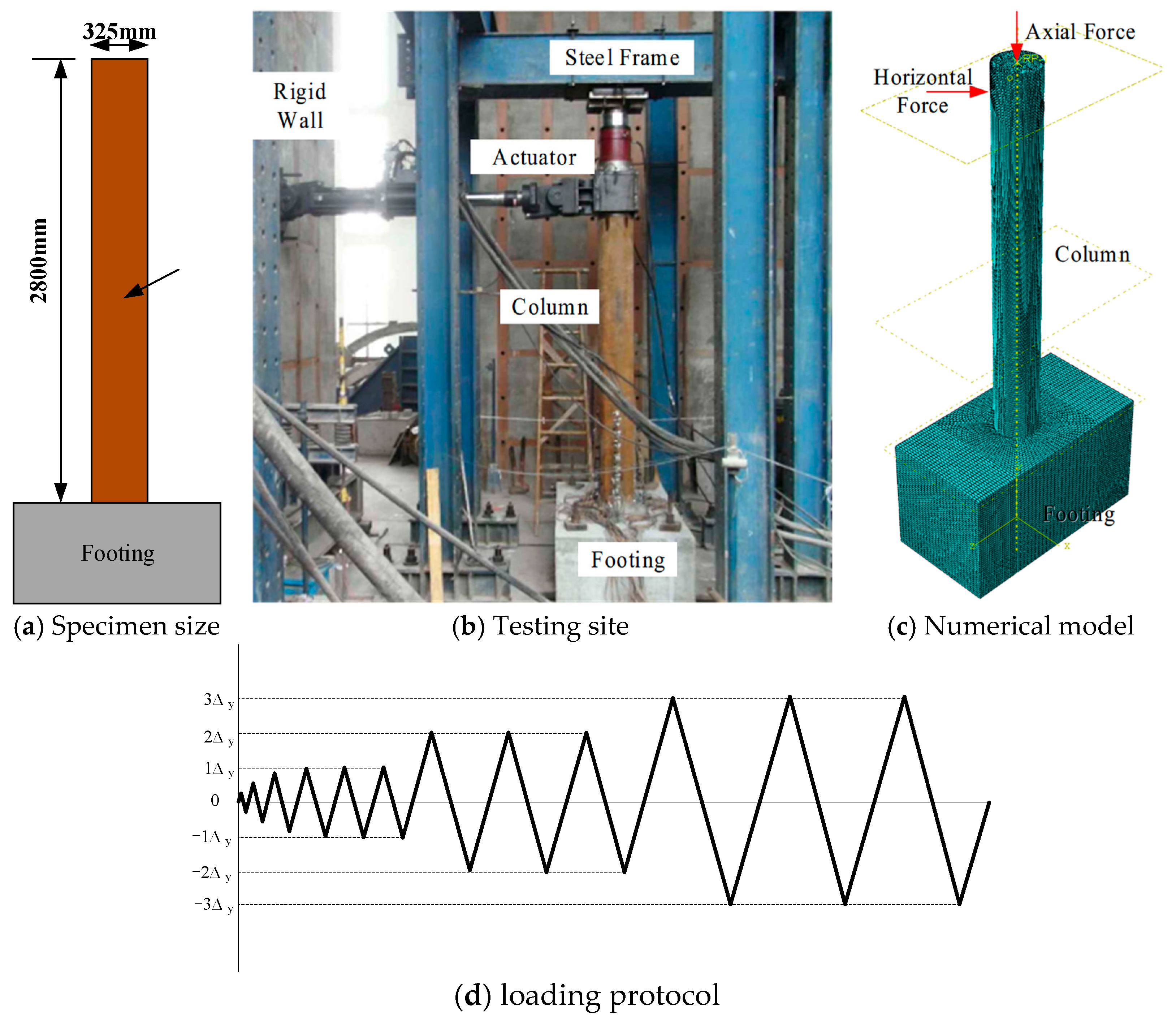
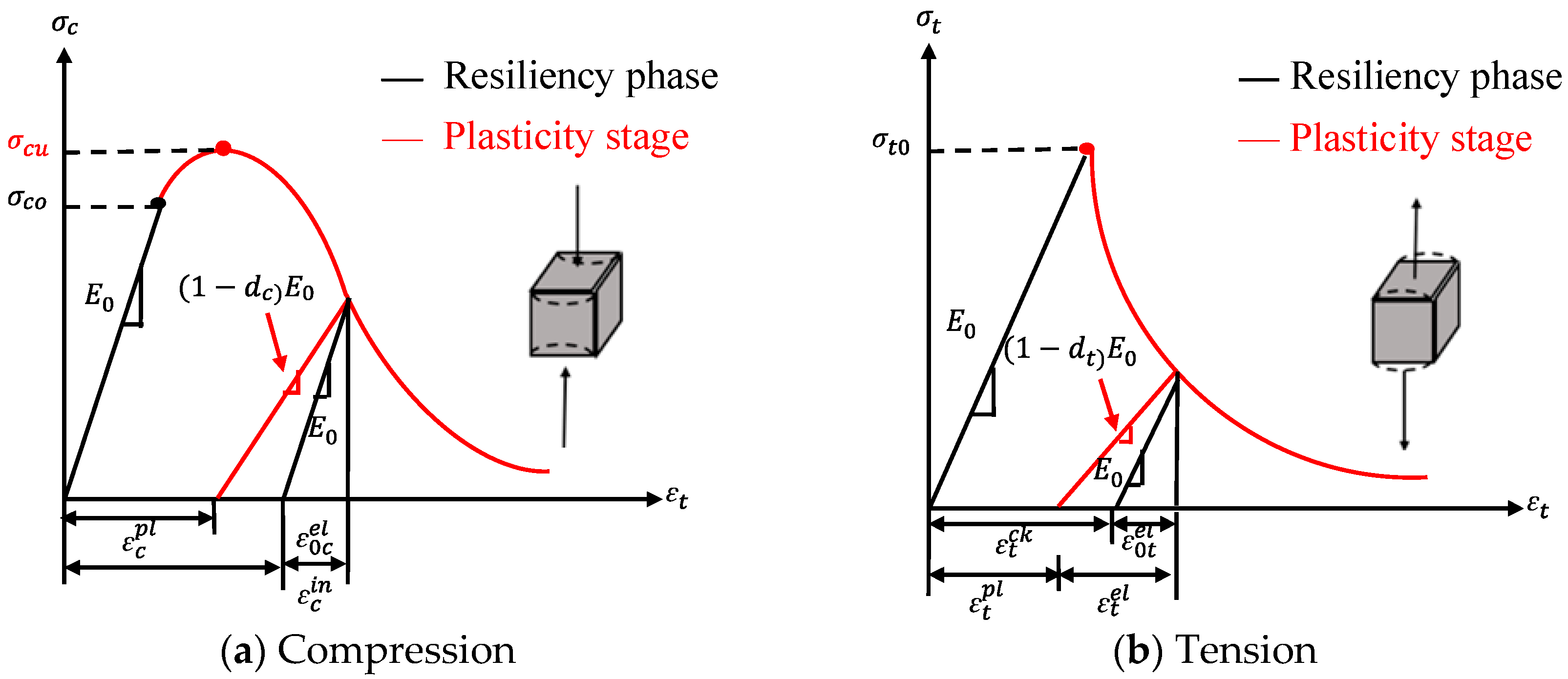


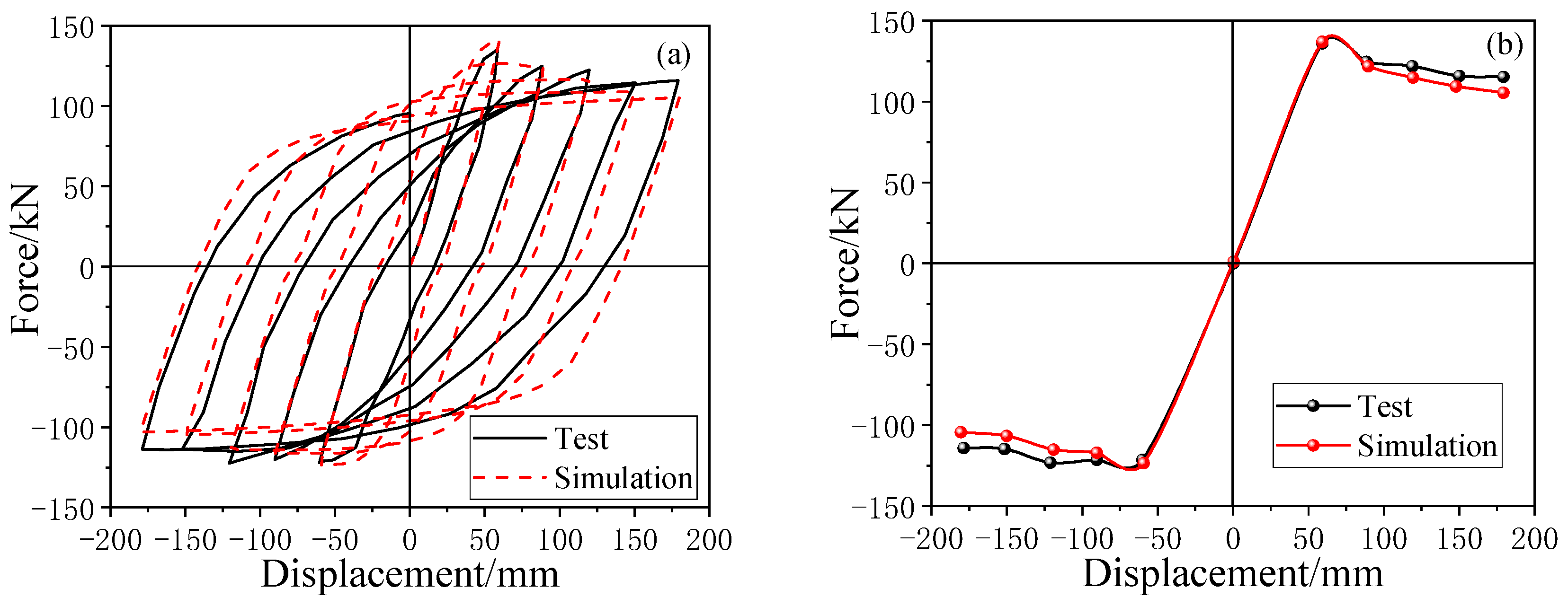
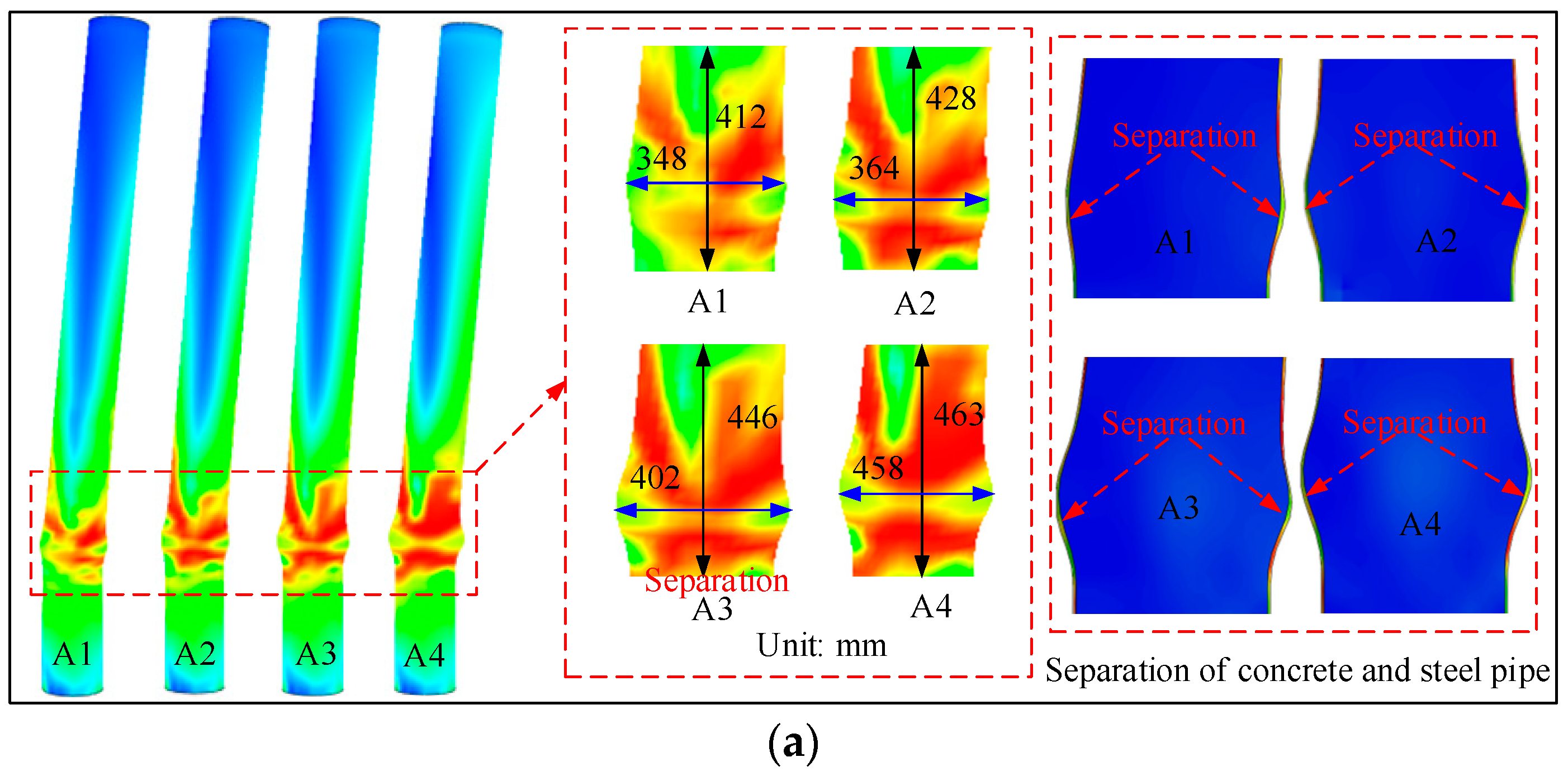




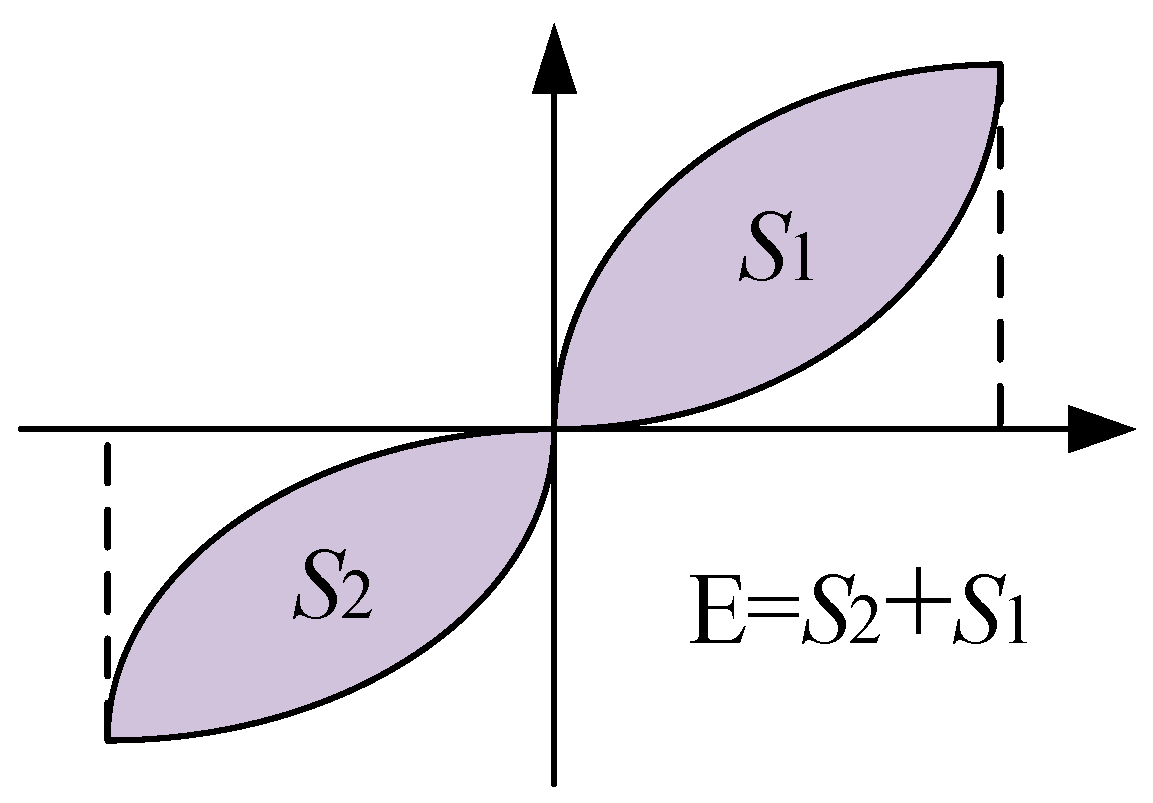


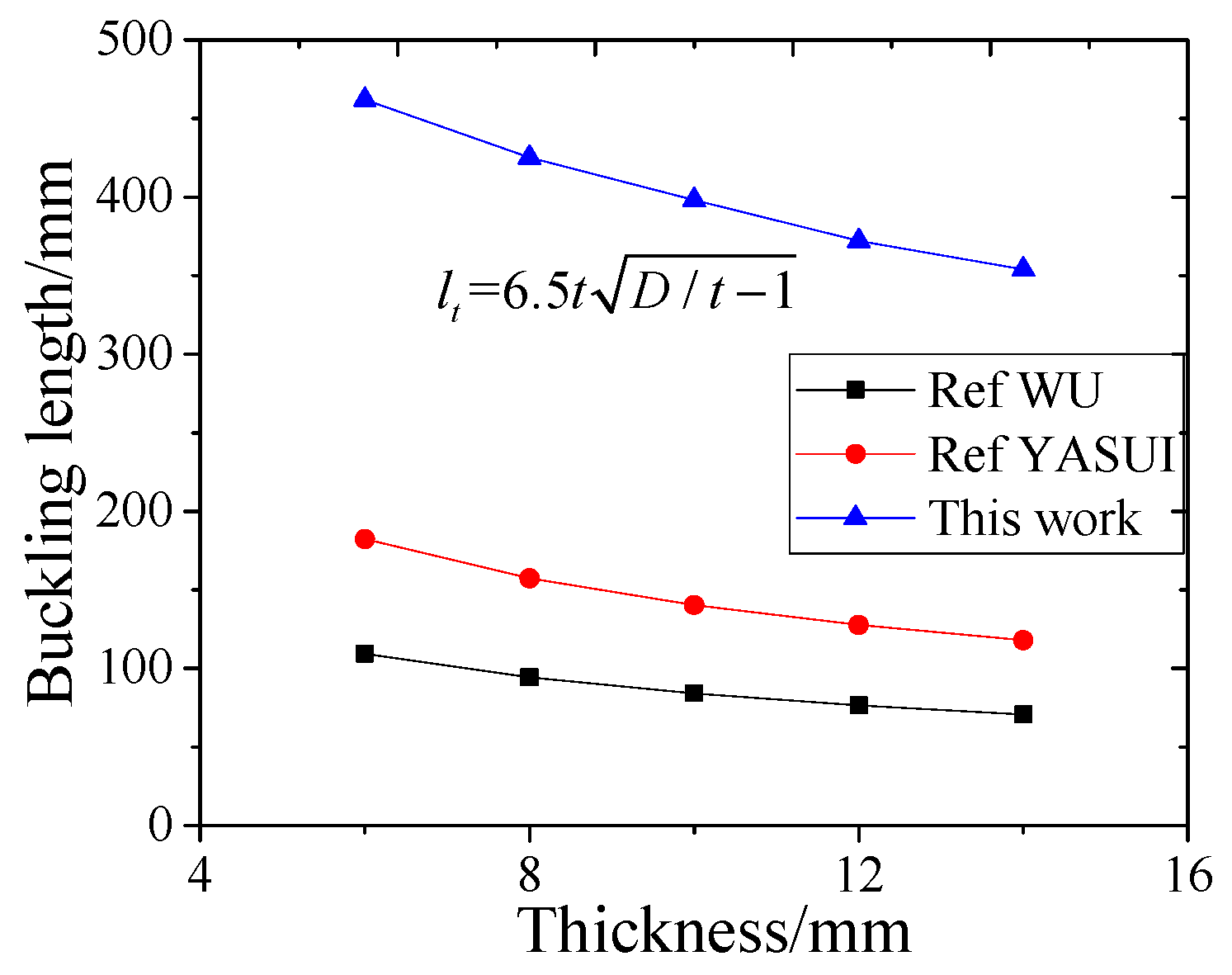
| Parameters | Values | Explanation |
|---|---|---|
| 30 | Dilation angle | |
| e | 0.1 | Flow potential eccentricity |
| 1.16 | The ratio of initial equibiaxial compressive yield stress to initial uniaxial compressive yield stress | |
| Kc | 0.6667 | The coefficient determining the shape of the deviatoric cross-section |
| 0.0005 | Viscosity parameter |
| Materials | Contents | Values |
|---|---|---|
| Concrete | Cube strength (MPa) Elastic modulus (GPa) Poisson’s ratio | 34.1 3.3 × 104 0.2 |
| Steel tube | Yielding strength (MPa) Ultimate strength (MPa) Elastic modulus (GPa) Poisson’s ratio | 277 316 2.1 × 105 0.3 |
| Case | Outer Diameter/mm | Length/mm | Wall Thickness/mm | Axial Force/kN | Axial Compression Ratio | Confinement Coefficient | Slenderness Ratio |
|---|---|---|---|---|---|---|---|
| Benchmark | 325 | 2800 | 10 | 528 | 0.1 | 1.1 | 34.5 |
| A1 | 325 | 2800 | 10 | 792 | 0.15 | 1.1 | 34.5 |
| A2 | 325 | 2800 | 10 | 1056 | 0.2 | 1.1 | 34.5 |
| A3 | 325 | 2800 | 10 | 1320 | 0.25 | 1.1 | 34.5 |
| A4 | 325 | 2800 | 10 | 1584 | 0.3 | 1.1 | 34.5 |
| B1 | 325 | 1800 | 10 | 528 | 0.1 | 1.1 | 22.2 |
| B2 | 325 | 2300 | 10 | 528 | 0.1 | 1.1 | 28.3 |
| B3 | 325 | 3300 | 10 | 528 | 0.1 | 1.1 | 40.6 |
| B4 | 325 | 3800 | 10 | 528 | 0.1 | 1.1 | 46.8 |
| C1 | 317 | 2800 | 6 | 528 | 0.1 | 0.65 | 35.3 |
| C2 | 321 | 2800 | 8 | 528 | 0.1 | 0.87 | 34.9 |
| C3 | 329 | 2800 | 12 | 528 | 0.1 | 1.33 | 34 |
| C4 | 333 | 2800 | 14 | 528 | 0.1 | 1.56 | 33.6 |
| Case | Yield Load/kN | Peak Load/kN | Failure Load/kN | Yield Displacement/mm | Peak Displacement/mm | Failure Displacement/mm |
|---|---|---|---|---|---|---|
| Verification | 96.3 | 137.1 | 116.5 | 22.6 | 59.3 | 119.3 |
| A1 | 97.1 | 138.3 | 117.6 | 22.3 | 58.6 | 113.6 |
| A2 | 99.2 | 140.2 | 119.2 | 21.8 | 57.8 | 105.3 |
| A3 | 103.6 | 142.6 | 121.2 | 20.6 | 56.5 | 93.4 |
| A4 | 108.5 | 145.8 | 123.9 | 19.7 | 56.2 | 78.6 |
| B1 | 142.6 | 235.6 | 200.3 | 15.6 | 57.3 | 76.8 |
| B2 | 102.2 | 163.5 | 139.0 | 19.3 | 58.6 | 106.5 |
| B3 | 78.5 | 116.8 | 99.3 | 22.3 | 59.8 | 123.2 |
| B4 | 55.3 | 82.2 | 69.9 | 32.6 | 79.6 | 198.6 |
| C1 | 105.2 | 168.5 | 61.7 | 23.6 | 57.6 | 115.9 |
| C2 | 98.6 | 156.2 | 81.9 | 25.3 | 58.3 | 126.8 |
| C3 | 65.2 | 96.3 | 132.8 | 24.7 | 60.5 | 163.3 |
| C4 | 48.3 | 72.6 | 143.2 | 36.2 | 76.9 | 255.6 |
Disclaimer/Publisher’s Note: The statements, opinions and data contained in all publications are solely those of the individual author(s) and contributor(s) and not of MDPI and/or the editor(s). MDPI and/or the editor(s) disclaim responsibility for any injury to people or property resulting from any ideas, methods, instructions or products referred to in the content. |
© 2025 by the authors. Licensee MDPI, Basel, Switzerland. This article is an open access article distributed under the terms and conditions of the Creative Commons Attribution (CC BY) license (https://creativecommons.org/licenses/by/4.0/).
Share and Cite
Zhou, Y.; He, H.; Cao, S.; Zhu, T.; Fei, Z.; Wu, M.; Tian, X. Seismic Performance and Buckling Length Calculation Method of Concrete-Filled Steel Tube Columns. Buildings 2025, 15, 4007. https://doi.org/10.3390/buildings15214007
Zhou Y, He H, Cao S, Zhu T, Fei Z, Wu M, Tian X. Seismic Performance and Buckling Length Calculation Method of Concrete-Filled Steel Tube Columns. Buildings. 2025; 15(21):4007. https://doi.org/10.3390/buildings15214007
Chicago/Turabian StyleZhou, Yulong, Haifang He, Shu Cao, Tong Zhu, Zhixuan Fei, Min Wu, and Xiang Tian. 2025. "Seismic Performance and Buckling Length Calculation Method of Concrete-Filled Steel Tube Columns" Buildings 15, no. 21: 4007. https://doi.org/10.3390/buildings15214007
APA StyleZhou, Y., He, H., Cao, S., Zhu, T., Fei, Z., Wu, M., & Tian, X. (2025). Seismic Performance and Buckling Length Calculation Method of Concrete-Filled Steel Tube Columns. Buildings, 15(21), 4007. https://doi.org/10.3390/buildings15214007








